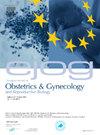Serum spexin levels as a biomarker for hyperemesis gravidarum: a case-control study
IF 1.9
4区 医学
Q2 OBSTETRICS & GYNECOLOGY
European journal of obstetrics, gynecology, and reproductive biology
Pub Date : 2025-07-01
DOI:10.1016/j.ejogrb.2025.114558
引用次数: 0
Abstract
Objective
The aim of this study was to evaluate the concentration of serum spexin (SPX) in pregnant women with hyperemesis gravidarum (HG) and to investigate its potential as a biomarker for disease severity.
Study design
A case-control study was conducted involving 44 pregnant women diagnosed with HG and 44 healthy controls matched for age, BMI and gestational age. The SPX concentration in serum was measured using an enzyme-linked immunosorbent assay (ELISA). Clinical and biochemical parameters, including ketonuria, thyroid hormones, liver enzymes, renal function tests and inflammatory markers, were also analysed.
Results
Serum SPX concentrations were significantly higher in the HG group compared to controls (1501 ± 635.2 pg/ml vs. 1186 ± 533.6 pg/ml, p = 0.014). HG patients had elevated white blood cell, neutrophil, ALT, AST, free T3 and free T4 levels, while TSH, creatinine and blood urea nitrogen (BUN) were significantly lower compared to controls (p < 0.05 for all comparisons). No significant correlation between SPX levels and gestational age was found. However, SPX levels negatively correlated with TSH (r = -0.275, p = 0.013) and BUN (r = -0.234, p = 0.028), and positively correlated with free T4 (r = 0.237, p = 0.033). ROC analysis identified a SPX cutoff level of > 1541 pg/ml to predict HG with a sensitivity of 57 % and a specificity of 73 % (AUC = 0.648, p = 0.013).
Conclusion
Although serum SPX levels were significantly elevated in HG patients, its moderate diagnostic performance and cross-sectional design limit its clinical applicability as a stand-alone biomarker. These findings should be considered preliminary and require validation by larger prospective studies.
血清精蛋白水平作为妊娠剧吐的生物标志物:一项病例对照研究
目的评价妊娠剧吐(HG)孕妇血清SPX (SPX)的浓度,并探讨其作为疾病严重程度生物标志物的潜力。研究设计进行了一项病例对照研究,涉及44名诊断为HG的孕妇和44名年龄、BMI和胎龄匹配的健康对照组。采用酶联免疫吸附试验(ELISA)测定血清中SPX浓度。还分析了临床和生化参数,包括酮尿、甲状腺激素、肝酶、肾功能测试和炎症标志物。结果HG组血清SPX浓度显著高于对照组(1501±635.2 pg/ml vs. 1186±533.6 pg/ml, p = 0.014)。HG患者白细胞、中性粒细胞、ALT、AST、游离T3、游离T4水平均升高,TSH、肌酐、血尿素氮(BUN)水平显著低于对照组(p <;0.05为所有比较)。SPX水平与胎龄无显著相关性。SPX水平与TSH (r = -0.275, p = 0.013)、BUN (r = -0.234, p = 0.028)呈负相关,与游离T4 (r = 0.237, p = 0.033)呈正相关。ROC分析确定标准普尔指数的临界值为>;1541 pg/ml预测HG的敏感性为57%,特异性为73% (AUC = 0.648, p = 0.013)。结论虽然血清SPX水平在HG患者中显著升高,但其诊断能力和横断面设计限制了其作为独立生物标志物的临床适用性。这些发现应该被认为是初步的,需要更大的前瞻性研究来验证。
本文章由计算机程序翻译,如有差异,请以英文原文为准。
求助全文
约1分钟内获得全文
求助全文
来源期刊
CiteScore
4.60
自引率
3.80%
发文量
898
审稿时长
8.3 weeks
期刊介绍:
The European Journal of Obstetrics & Gynecology and Reproductive Biology is the leading general clinical journal covering the continent. It publishes peer reviewed original research articles, as well as a wide range of news, book reviews, biographical, historical and educational articles and a lively correspondence section. Fields covered include obstetrics, prenatal diagnosis, maternal-fetal medicine, perinatology, general gynecology, gynecologic oncology, uro-gynecology, reproductive medicine, infertility, reproductive endocrinology, sexual medicine and reproductive ethics. The European Journal of Obstetrics & Gynecology and Reproductive Biology provides a forum for scientific and clinical professional communication in obstetrics and gynecology throughout Europe and the world.

 求助内容:
求助内容: 应助结果提醒方式:
应助结果提醒方式:


